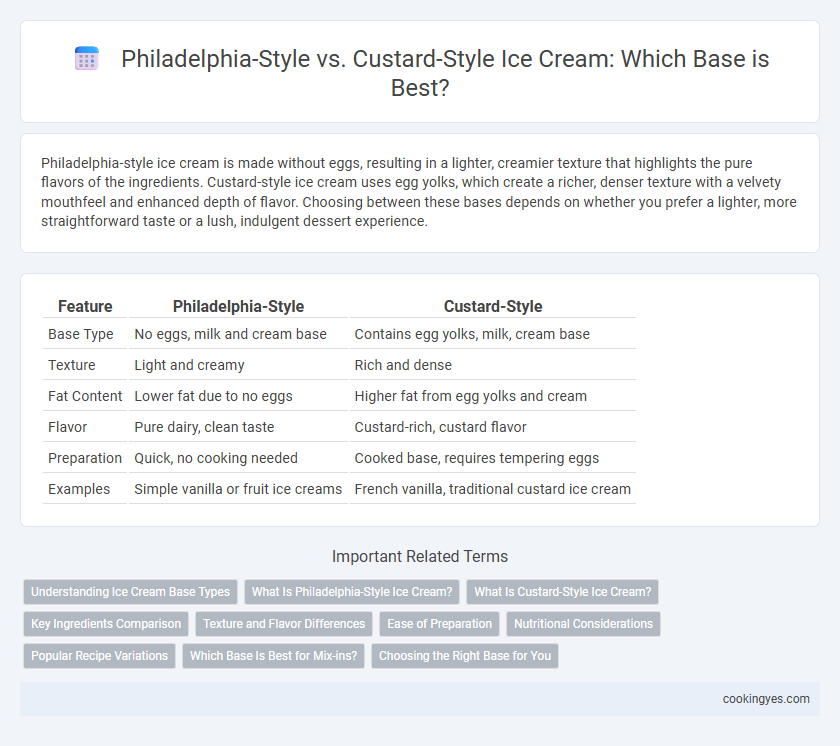Philadelphia-style ice cream is made without eggs, resulting in a lighter, creamier texture that highlights the pure flavors of the ingredients. Custard-style ice cream uses egg yolks, which create a richer, denser texture with a velvety mouthfeel and enhanced depth of flavor. Choosing between these bases depends on whether you prefer a lighter, more straightforward taste or a lush, indulgent dessert experience.
Table of Comparison
| Feature | Philadelphia-Style | Custard-Style |
|---|---|---|
| Base Type | No eggs, milk and cream base | Contains egg yolks, milk, cream base |
| Texture | Light and creamy | Rich and dense |
| Fat Content | Lower fat due to no eggs | Higher fat from egg yolks and cream |
| Flavor | Pure dairy, clean taste | Custard-rich, custard flavor |
| Preparation | Quick, no cooking needed | Cooked base, requires tempering eggs |
| Examples | Simple vanilla or fruit ice creams | French vanilla, traditional custard ice cream |
Understanding Ice Cream Base Types
Philadelphia-style ice cream features a custard-free base made primarily from cream, sugar, and flavorings, resulting in a lighter, creamier texture with a more pronounced dairy flavor. Custard-style ice cream relies heavily on egg yolks in its base, creating a richer, denser product with a smooth, velvety mouthfeel and increased fat content. Understanding these fundamental base differences helps in selecting the ideal ice cream texture and flavor intensity preferred by consumers.
What Is Philadelphia-Style Ice Cream?
Philadelphia-style ice cream is characterized by its simple base made without eggs, relying primarily on cream, milk, and sugar to create a light and creamy texture. Unlike custard-style ice cream, which uses egg yolks to achieve a richer and denser consistency, Philadelphia-style emphasizes a pure, clean dairy flavor. This style originated in the United States and remains popular for those seeking a less heavy, more straightforward ice cream experience.
What Is Custard-Style Ice Cream?
Custard-style ice cream is distinguished by its high egg yolk content, typically using at least 1.4% egg yolk solids, which creates a richer, creamier texture compared to Philadelphia-style ice cream that contains no eggs. This style undergoes slow churning and is often heated, resulting in a dense, smooth mouthfeel with a pronounced custard flavor. Popular in regions like the Midwest, custard-style ice cream combines heavy cream, milk, sugar, and egg yolks, offering a luxurious alternative to the lighter, egg-free Philadelphia-style base.
Key Ingredients Comparison
Philadelphia-style ice cream uses a simple base of milk, cream, and sugar without eggs, creating a lighter and smoother texture. Custard-style ice cream incorporates egg yolks along with cream and sugar, resulting in a richer, creamier consistency with a velvety mouthfeel. The presence of egg yolks in custard-style enhances emulsification and provides a distinctive, dense texture compared to the airy, delicate nature of Philadelphia-style.
Texture and Flavor Differences
Philadelphia-style ice cream features a smooth, creamy texture with a light, pure dairy flavor achieved by omitting eggs from its base, resulting in a more pronounced milk and cream taste. Custard-style ice cream incorporates egg yolks, giving it a richer, denser texture and a velvety mouthfeel, accompanied by a deeper, more complex flavor profile often described as custardy or egg-rich. The egg yolks in custard-style also contribute to a golden hue and a silkier consistency compared to the lighter, fluffier Philadelphia-style.
Ease of Preparation
Philadelphia-style ice cream is easier to prepare because it uses a simple base without eggs, relying mainly on cream, milk, and sugar, which reduces cooking time and complexity. Custard-style ice cream requires heating and tempering eggs to create a rich, thick base, making it more time-consuming and requiring careful temperature control. For quick and straightforward preparation, Philadelphia-style is preferred due to its minimal ingredient handling and faster process.
Nutritional Considerations
Philadelphia-style ice cream typically contains no eggs, resulting in a lower fat and cholesterol content compared to custard-style, which uses egg yolks for a richer, creamier texture. Nutritionally, Philadelphia-style offers fewer calories and saturated fats, making it a lighter option for those monitoring heart health. Custard-style, while higher in vitamins A and D due to egg content, may not be ideal for individuals with dietary fat restrictions or cholesterol concerns.
Popular Recipe Variations
Philadelphia-style ice cream features a custard-free base made primarily from cream, milk, and sugar, resulting in a lighter texture with a crisp vanilla flavor. Custard-style ice cream incorporates egg yolks into the base, creating a richer, creamier consistency with a velvety mouthfeel and deeper flavor profiles. Popular recipe variations of Philadelphia-style often include mix-ins like fruit or chocolate chips, while custard-style recipes emphasize slow churning and aging processes to enhance smoothness and flavor intensity.
Which Base Is Best for Mix-ins?
Philadelphia-style ice cream uses a milk-based, egg-free base that provides a lighter texture, allowing mix-ins to stand out without being overwhelmed by richness. Custard-style ice cream contains egg yolks, creating a creamier, denser base that blends harmoniously with mix-ins, offering a smoother, more cohesive flavor. For robust or chunky mix-ins, Philadelphia-style highlights contrast, while custard-style enhances overall creaminess.
Choosing the Right Base for You
Philadelphia-style ice cream features a simple base made without eggs, resulting in a lighter texture and cleaner flavor profile. Custard-style ice cream incorporates egg yolks in its base, creating a richer, creamier consistency and a more pronounced, velvety mouthfeel. Selecting the right base depends on your preference for either a lighter treat or a denser, silkier indulgence with deeper flavor complexity.
Philadelphia-Style vs Custard-Style for base type Infographic

 cookingyes.com
cookingyes.com